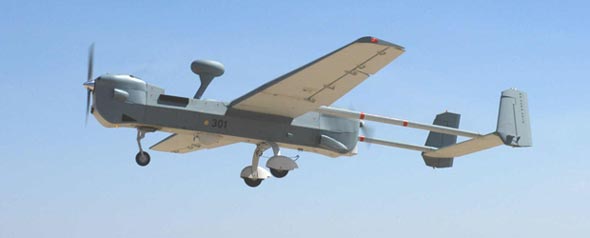Northrop Grumman Corporation’s (NYSE:NOC) Hunter Unmanned Aircraft System (UAS), in use with the U.S. Army since 1996, recently surpassed 50,000 flight hours in service, over half of which were flown in combat over Iraq and the former Yugoslavia. Northrop Grumman-operated Hunter MQ-5A and Army-operated MQ-5B models are currently deployed in the Global War on Terrorism. Hunter provides warfighters with state-of-the-art reconnaissance, surveillance, target acquisition (RSTA), communications relay, and weapons delivery. Hunter is currently operated by the US, French and Belgian armies.

The RQ-5A Hunter was the Army’s first fielded UAS. Hunter is capable of covering ranges of 125 to 250 km utilizing air data relay. Flying typical missions at 70 kts, with occasional dashes, Hunter’s endurance was increased from 12 hours to 21 hours, with the introduction of wet extended center wing and new Heavy Fuel Engines (HFE, using diesel or jet fuel) (see below).
Currently deployed with aerial exploitation companies in support to III corps, XVIII Airborne Corps and V corps, Hunter was the first UAV in US Army inventory to demonstrate weapons capability. In 2003 Hunter was tested with acoustic/IR homing BAT weapon, as well as a modified laser designated BAT, called Viper Strike. In 2004 the Hunter’s engines were replaced from the two-stroke MotoGuzzi gasoline engine to a three cylinder commercial JP-8 fuel engines. This heavy fuel engine improves performance and simplifies the logistics and support of the system in the field. A Hunter UAV system includes three ground control stations, two ground data terminals, six Hunter aerial vehicles and six IAI/Tamam MOSP EO/IR day/night payloads, offering imagery with focal length of 280mm up to 770mm. Three airborne relay datalinks are employed by the unit for extended range operations.
The MQ-5B is the advanced version of the system enhanced with a modern avionics suite, heavy fuel engines, and inclusion of “wet” (fuel-carrying) extended center wing and introduction of weapons-capable hard points. The MQ-5B Hunter system uses the US Army’s ‘One System’ ground control station and remote video terminal. It also carries a communications relay package to extend the radio range of warfighters. A differential GPS automatic takeoff and landing system is under development for Hunter. The MQ-5B can carry two Viper Strike munitions on a 16 hours mission.
The aircraft features a robust, fixed-wing, twin tail-boom design with redundant control systems powered by two heavy fuel engines – one engine to “push” and another to “pull” the air vehicle. A unique Hunter capability is its relay mode that allows one Hunter to be controlled by another UAV at extended ranges or over terrain obstacles typical of those found in the Balkans and Afghanistan.
To replace obsolete systems, increase readiness and reduce the logistics burden on soldiers, Northrop Grumman integrated a new suite of avionics for Hunter, including upgraded flight and mission computers, an auxiliary power distribution unit, the LN-251 inertial navigation system and GPS units, a downsized data link system, and an APX-118 IFF transponder. The avionics suite improves performance by reducing size, weight, and power consumption of the equipment used to control the aircraft and manage its critical subsystems.
In 2006 the Hunter was used to test an Adaptive Joint Intelligence payload – a new reconfigurable payload that will allow users to share multiple types of communications simultaneously; a capability that is not yet available to warfighters in the field. The software-driven payload will be reconfigurable to operate as a communications relay, a signals intelligence-gathering device or an electronic-warfare tool.
Further enhancements were demonstrated by the E-Hunter program, utilizing a 54.5 foot wing and a new tail assembly, both derived from the Hunter II aerial vehicle. The Northrop-Grumman’s Hunter II proposal for the ER/MP program was based on an enlarged variant of the Hunter UAV, leveraging modern avionics from MQ-5B Hunter system. Eventually, the US Army selected the Sky warrior – proposed by General Atomics. With the HFE engine, E-Hunter could take off at a maximum weight of 2,200 lbs, on a 40 hours mission at a ceiling of up to 25,000′. The new wings and tail are designed to carry a variety of external sensors, communications, EW and weapons payloads. E-Hunter was flown for the first time on March 17, 2005. as part of an on-going cooperative effort between Northrop Grumman and the US Army, to extend the range, endurance and payload capacity of the Hunter UAV system. The modification will be offered as a field installable kit.
















